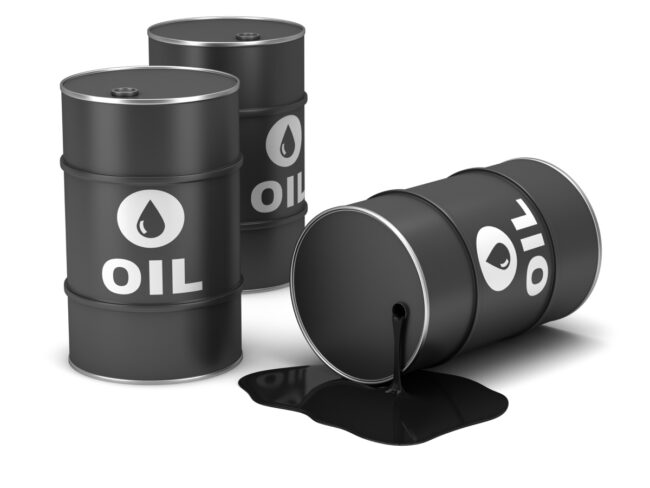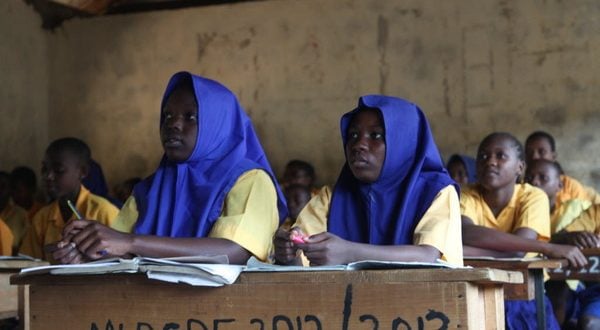With more than half its population lacking access to energy, Nigeria still wastes gas —a major source of energy. The communities where the gas is flared are also bereft of any form of protection and empowerment. The stories of these women point to what would have been if only the government would add a smidgen of grit to its promise to turn wasted gas into money. ABIOSE ADELAJA ADAMS reports on the plight of women who use heat from gas flaring sites to dry tapioca.
Inside Eruemukohwarien, a community that is home to Ughelli East Gas Plant, it is always hot and bright. The residents don’t know the difference between the coolness of the night and the heat of the day, as raging flames have rolled out, noisily, non-stop, every day for the last 55 years.
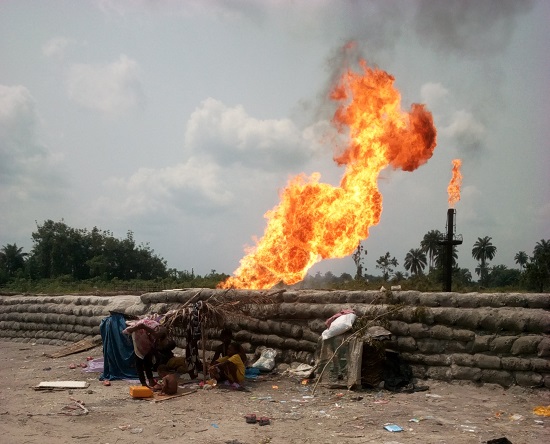
The plant, operated by ND Western in partnership with Nigeria Petroleum Development Company (NPDC), a subsidiary of NNPC under Oil Mining License, OML 34, has been existing since 1966, and it supplies gas to Transcorp Ughelli power station.
However, despite its important role in power supply and wealth generation to the nation, the community which houses this plant is clobbered into poverty— no electricity, no healthcare, no jobs for the youths.
Advertisement
CAN’T AFFORD GAS OVEN
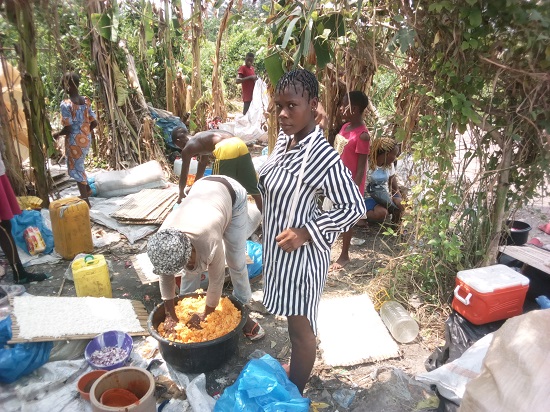
On the day of the visit, TheCable met Joy Peter, one of nine women spotted under a banana tree, a few metres from the raging flame. In what looked like a mini-factory, they were kneading wet tapioca pulp, popularly called kpo-kpo garri, and spreading it on a wooden mat, after which they would head-load it on their children —between ages 10 and 12 — to be dried right under flaring gas pipes.
Bus and tricycle drivers were also seen in this local factory, off-loading more bags of wet cassava roots whilst transporting the dried flakes for sales at markets across Delta state.
Advertisement
Joy and her folks live in a neighbouring community, but rather than use sunlight which they say is slow, they are drawn to the heat of the flame, saying they cannot afford a gas oven.
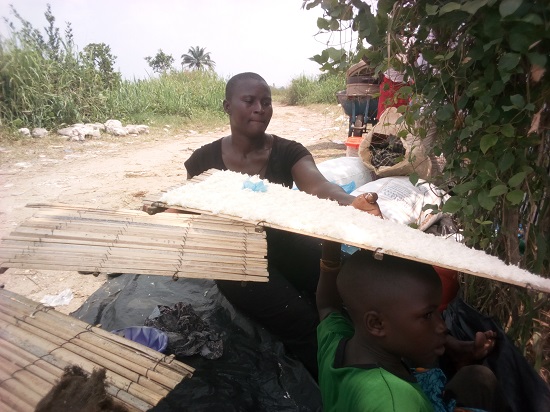
“Let the government empower us. This is hard labour. The heat from this place is giving us fever and killing us slowly, but since we have no other means of livelihood, this is what we are using to put food on the table and pay our children’s school fees,” she said.
Drenched in sweat and with a face scorched by the heat, Joy stared into the wagging tongues of fire as she explained their trade.
“If we dry it (the wet tapioca pulp) under the sun, it will take three days. And that kind of tapioca does not rise quickly (in hot water), it does not taste good, and it does not sell quickly,” she said in Pidgin English.
Advertisement
“But the one we dry here (with flare gas), dries quickly, it is sweeter and rises well in hot water. In three hours, it has dried, so we can take it to the market and sell quickly and make our gain quickly.”
‘GAS FLARE IS KILLING US SLOWLY’
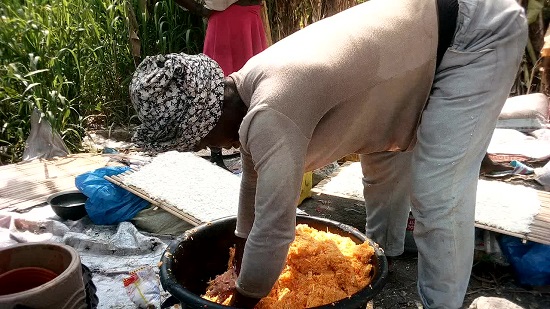
On the floor beside Clara Obi is the paraphernalia of a cook; diced onions, palm oil, seasoning cubes, and a slightly red tapioca pulp. Clara was there with her three sisters.
“This is our family business. We buy bags of cassava roots, bring it here to dry in front of the fire. This thing I am making is red tapioca. We add palm oil, maggi and onion. It is very sweet, and moves well in the market,” she said.
Advertisement
Asked how much profit they make from it, Clara said: “We make at least N5,000 in a week. We work four times a week, both day and night.”
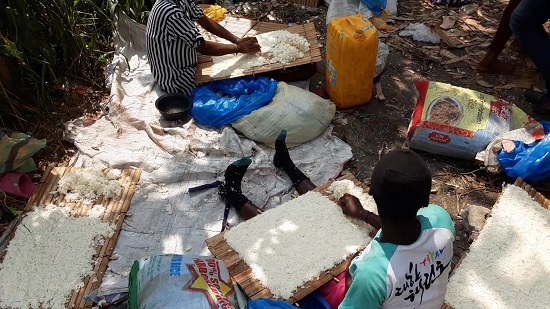
When asked if the heat of the flames and the soot doesn’t affect them, the women chorused: “Ah! It is killing us oh.” Clara further explained: “It used to generate fever in our body. But we maintain ourselves by drinking malt and milk after work.”
Advertisement
Tapioca, a cassava derivative, is a light meal often used as a delicacy in breakfasts and as desserts. The women say there is a high demand for it in Delta, and it is often exported in big sacks to other states.
‘POISONOUS’ TAPIOCA IN CIRCULATION
Advertisement
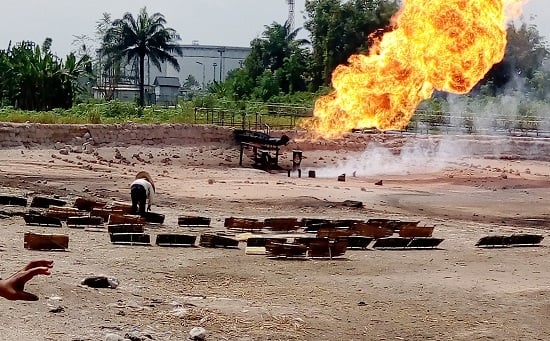
If women like Joy and Clara could afford cooking gas, they would not need to face the fiery fire or expose themselves to potentially poisonous gases.
A study published by Research Gate in the International Journal of Applied Physics in 2012 found that chemicals emitted in a gas flare contain heavy metals such as benzene, toluene, and xylenes.
Advertisement
Prolonged exposure to these is known to cause birth abnormalities, kidney/organ failure, cancers, and innumerable health complications. If these women knew better or were empowered with alternatives, they would be drying the tapioca pulp with a gas oven that costs between N50,000-N65,000, thereby eliminating the production of potentially poisonous tapioca.
SUFFERING AMIDST PLENTY
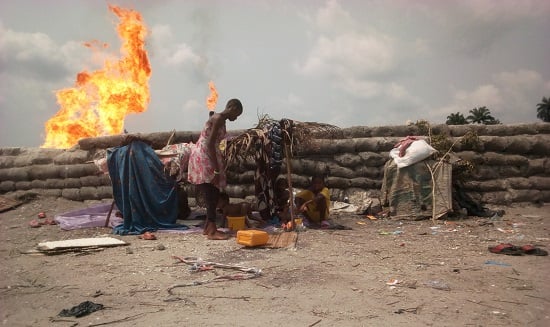
But their plight speaks to the reality of many Nigerians who are suffering in the midst of plenty; resource-rich but energy-poor; no access to electricity and cooking fuels despite the country’s immense gas potential. Nigeria, with the largest proven gas reserves in Africa and the ninth-largest in the world, flares around eight billion cubic meters of gas annually, according to the World Bank.
The Global Gas Flare Tracker Report rates Nigeria as the seventh-largest gas flaring country and the second-largest in Africa, after Algeria. Apart from the health and environmental impacts, there is the wasted opportunity of wealth and power generation.
Official figures from the petroleum ministry show that the quantity of gas flared in 2020 alone is enough to provide 35,400 gigawatts of electricity, equivalent to the annual electricity use of 804 million Nigerians.
This is further worsened by the loss of $1 billion worth of revenue, owing to the inability to capture and commercialise associated gas.
“NO MEANINGFUL DEVELOPMENT HERE”
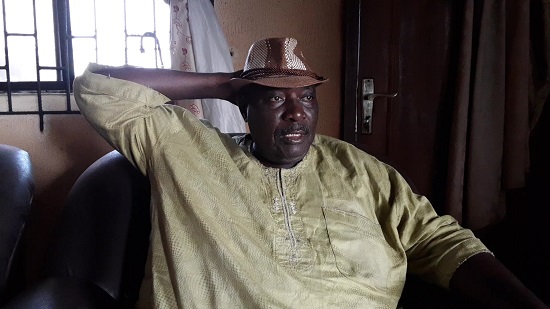
Exasperated, Julius Oyikoba, one of the leaders in the community, told TheCable that both the oil companies and Nigerian government have neglected the community from where they are benefiting.
“Look at us, we are not well. We can’t sleep at night. We will remove all our clothes to collect breeze. Even the breeze here is hot. Inside our house is hot, because the whole zinc would have absorbed heat, and it is all red in colour because of the flare. In the night it is worse because they (oil company) usually increase it (the intensity of the gas flare) at night. When it rains, it pours out black soot, what they call acid rain,” he lamented.
“They are just using us. Go into these companies and find out how many indigenous community members are management staff. Even our graduates that read petroleum engineering in universities, cannot get in. The oil companies don’t keep to their agreement to pay their community levy. It is as if there is a policy in oil companies to silence oil-producing communities.”
He added: “I had to relocate out of that town. It’s always hot. You can’t even put on clothes. In the morning and night, there is no cool breeze. It is always hot, noisy and the air smells of chemicals. And if you look around, there is no meaningful development in the community.”
‘NO ONE HEARS OUR CRY’
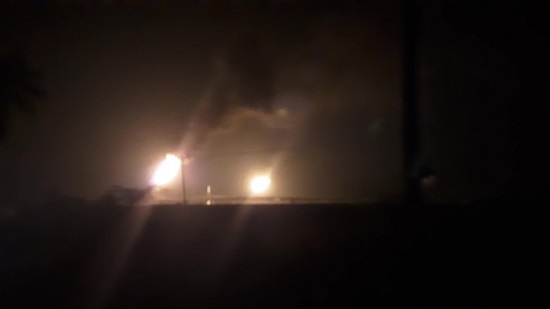
At another gas flare site in Omok, a community under Ogba/Egbema/Ndoni LGA of Rivers state, residents who spoke to TheCable said the chemicals from the gas flaring are killing them slowly.
“It disturbs us, but no one hears our cry. We have complained and complained, we have written letters but nothing has been done,” says one shop owner in Omok, who identified himself as Alexander.
This site is operated by the Nigerian Agip Oil Company (NAOC) in a joint venture with the federal government, and the two gas pipes belching fire and black plumes into the air towers over a popular shopping mall. People were seen buying and selling, and eating in open-air restaurants.
“We can never be used to it. We are just managing it. When you got to the hospital, the common complaint is catarrh and cough,” Alexander added.
Residents, however, say the only positive is that Agip gives the community free electricity. Nevertheless, it doesn’t compensate for the damage done to their health.
NIGERIA’S PROMISE TO TRAP FLARE GAS
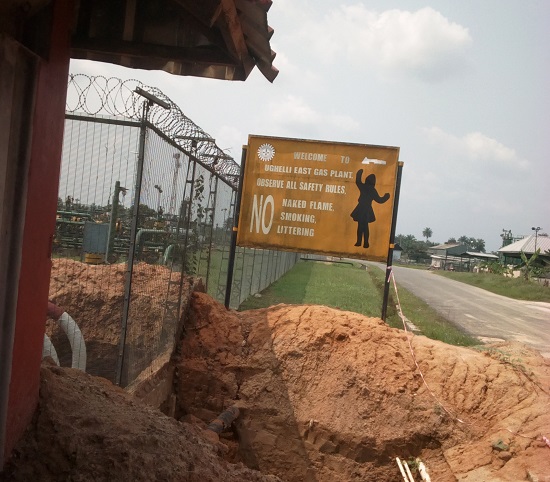
Oil exploration comes with the release of associated gas. The standard practice is to trap the gas released and convert it for commercial use, but in Nigeria, the gas is released into the atmosphere and it comes out as fire.
Nigeria is a signatory to the Paris Accord, a global alliance to reverse the trend of global warming. It is also a signatory to the Global Gas Flaring Partnership (GGFR). And as part of its commitment to reverse this trend, it pledged to eliminate gas flaring by the end of 2020.
This birthed the Nigeria Gas Flare Commercialisation Programme (NGFCP), which was launched in October 2016. It is aimed at harnessing flared gas to stimulate economic growth, drive investments and provide jobs in oil-producing communities.
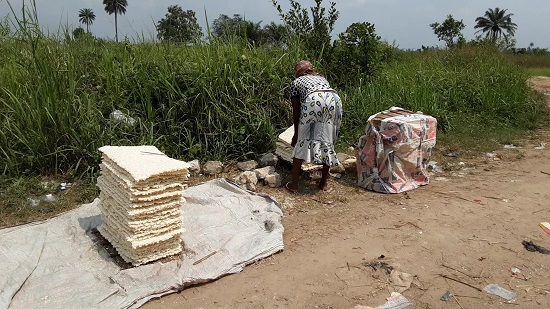
Five years after the launch of this programme, little has been heard of its progress. The most recent information was published on February 28, 2020, on the website of the Department of Petroleum Resources (DPR). Sarki Auwalu, the director, had noted that “200 bidders have been shortlisted from 800 who expressed interest in converting associated gas for commercial use”.
Nigeria has not kept its word to end this 60-year-old environmentally harmful practice of gas flaring. Rather, it keeps shifting deadlines; from January 1984 to December 2007, and onwards till 2020.
The latest is another promise to end flaring in 2025. Timipre Sylva, minister of state for petroleum resources, recently told the house of representatives at a public hearing that the country means business this time around. While these communities continue to suffer, it is hoped that the commercialisation programme will not tow the same path of inaction.
This special investigative report on environmental and climate justice is supported by Bertha Foundation
